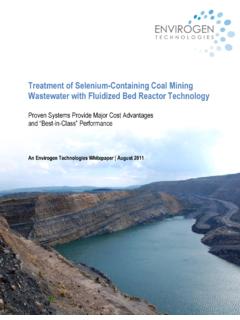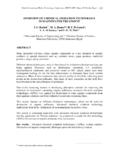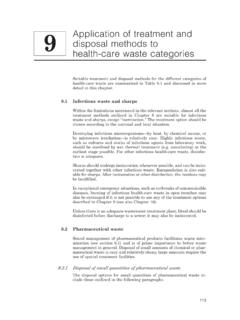Transcription of Managing the New FGD Wastewater Regulations - Envirogen
1 Managing the New FGD Wastewater Regulations technology Options for Biological treatment : Maximum treatment Reliability with Lowest Lifecycle Cost 1. Table of Contents Introduction .. 3. Overview of Best Performing Technologies .. 3. The New Regulatory Environment .. 4. Characterizing FGD Wastewater .. 6. FGD Wastewater treatment Technologies .. 7. treatment of Selenium-Containing Wastewaters .. 8. Envirogen Fluidized Bed Reactor technology .. 10. Base System 11. System Operation .. 11. The Fixed-Film Bioreactor Challenge .. 13. Optimization of microorganism efficiency .. 13. Smaller overall footprint .. 14. Steady-state operation .. 14. Robustness of the system .. 14. Lower costs .. 15. The Anaerobic Membrane Bioreactor .. 15. Solids Management: Field Systems and Pilot Testing Experience .. 17. Large Scale Pilot Study Shows Two Winners.
2 18. Choosing a Way Forward: Performance, Flexibility and Track .. 20. Afterword: Envirogen in the Power Industry .. 21. Managing the New FGD Wastewater Regulations 2. Introduction The Environmental Protection Agency's recent update of the Steam Electric Power Generating Effluent Guidelines (commonly called effluent limitation guidelines or ELGs) has far reaching consequences on how coal-fired power plants will operate and, in particular, manage their Wastewater in the future. One of the most complex and demanding segments on of the new ELGs concerns Managing Flue Gas Desulfurization (FGD). Wastewater . The ELGs set a host of new numerical limits for total dissolved solids, arsenic, mercury, selenium, and nitrate for FGD. Wastewater . The ELGs are technology -based Regulations , which means the limitations set by the EPA under this rule are established based on what is achievable given the implementation of a certain treatment technology the agency selects as a basis for consideration.
3 A number of different technologies have been suggested by the EPA as trusted', and while each of these exhibits efficacy in addressing some portion of the Wastewater treatment challenge, many have substantial limitations based on the nature of the Wastewater stream, their ability to treat a broad range of the contaminants in question reliably, and their cost. This has been particularly shown to be the case in meeting selenium discharge requirements, where biological treatment systems have been shown to offer superior treatment efficacy as well as other benefits. Two Top-Performing technology Approaches Today, Envirogen Technologies offers the two most reliable biological technologies for treating FGD. Wastewater : the Fluidized Bed Reactor (FBR) and the Anaerobic Membrane Bioreactor (AnMBR). In pilot testing conducted during 2013-2014 by the Electric Power Research Institute (results published in 2015), both of these technologies graded out as top performers compared to other treatment options.
4 In addition to delivering the most consistent removal of selenium and other metals, these technologies have the benefits of greater system reliability and significantly lower costs than other commercially-available technologies. Envirogen has the broadest background and installation-base of biological treatment Managing the New FGD Wastewater Regulations 3. systems for both selenium and other oxyanions in the environmental industry. This track record of designing, building and even operating biological systems offers the engineering community and power utilities a strong partner in developing reliable, least-cost solutions to Managing FGD Wastewater treatment operations under the new ELGs. The New Regulatory Environment FIGURE 1: While impacting around 1,000. facilities throughout the United States, the segment of the new ELGs rule that regulates FGD.
5 Wastewater will have the greatest impact on fewer than 500. (generating capacity greater than 50MW) of these power plants that are coal-fired units that discharge to a surface water body via a National Pollutant Discharge Elimination System (NPDES) permit (direct dischargers) or discharge to a publicly owned treatment works (POTW) via a pretreatment permit (indirect dischargers). The rule creates more stringent effluent limitations on arsenic, mercury, selenium, and nitrate/nitrite for flue gas desulfurization waste streams and ash transport water. Under these new rules (Figure 1), the EPA wants compliance as soon as possible beginning on November 1, 2018, but no later than December 31, 2023. According to EPA's technical development document, the flexibility considerations include time to expeditiously plan (including to raise capital), design, procure, and install equipment to comply with the requirements, timing of the plant's National Pollutant Discharge Elimination System (NPDES) permit renewal, and any competing/additional changes being made at the plant to satisfy other standards and Regulations .
6 For existing facilities, the new ELGs consider two tracks' for compliance a Wastewater treatment /discharge track and a zero liquid discharge (ZLD)/disposal track. For the ZLD/disposal track, Managing the New FGD Wastewater Regulations 4. the EPA offers an incentive that extends the ELG compliance deadline to December 31, 2023, regardless of permit renewal date for any existing FGD Wastewater generators who voluntarily accept a more stringent technology basis for treatment of FGD Wastewater vapor-compression evaporation and agree to be subjected to numerical limits for mercury, arsenic, selenium, and TDS commensurate with this treatment technology . For the Wastewater treatment / discharge track, treatment and discharge of the Wastewater are regulated as described in the Effluent Guidelines. An advantage of this track is that it is has the potential to be significantly less expensive.
7 On the downside, the discharge limits for the Wastewater treatment track are very stringent and future amendments to discharge limits are possible. The 2015 ELGs update focuses on six power plant Wastewater streams: Flue gas mercury control (FGMC) system Wastewater Bottom ash transport waters Fly ash transport waters Flue gas desulfurization (FGD) Wastewater Coal combustion residuals (CCR) leachate Integrated Gasification Combined Cycle (IGCC). Wastewater FGD Wastewater is defined by the EPA to include any process Wastewater generated specifically from the wet flue gas desulfurization scrubber system, including any solids separation or solids dewatering processes . This paper will focus on the most complex section of the new rule FGD Wastewater . Industry experts agree that this area will demand the greatest level of engineering, design, planning and investment in treatment systems with the longest lead times to successful project completion.
8 Managing the New FGD Wastewater Regulations 5. Characterizing FGD Wastewater FGD Wastewater poses a challenge to treat because of high concentrations of TDS and TSS, supersaturation in sulfates, high temperatures, potentially high organic concentrations, ammonia, nitrates and nitrites and heavy metals and trace constituents. TABLE 4: Numerous studies have shown that FGD. Wastewater composition varies significantly from facility to facility and even within a single facility over time. The Wastewater flowrate and characterization are affected by a number of factors, including the coal burn rate, scrubber equilibrium chloride concentrations, effectiveness of fly ash removal, the gypsum dewatering system, type of FGD process, and composition of the coal, limestone and make-up water. The purge rate required to maintain a target equilibrium chloride concentration is directly dependent on the coal chloride content and coal burn rate.
9 FGD Wastewater may contain as much as 7%. suspended solids (if primary hydrocyclone overflow is used) or as little as 30 mg/L of suspended solids (when using thickener or stacking pond overflow). Moreover, because it is common for a plant to change coal and limestone suppliers, the Wastewater constituents will change over time during operation of the FGD system. FGD Wastewater can contain high levels of selenium, mercury, hexavalent chrome, cadmium, copper, and zinc in various phases of speciation. An emerging body of study points to the oxidation state of FGD wastewaters as measured by oxidation reduction potential (ORP) - as a key factor in the treatability of metals and the attainment of low discharge levels directed by the ELGs. For many metals, Managing the New FGD Wastewater Regulations 6. both concentration and solubility are a function of the oxidation state.
10 As swings in condition of the FGD. Wastewater occur, ORP may produce changes in the dominant state of regulated metals. For example, there is a strong correlation between ORP and Se concentration. As the ORP drops, there is a corresponding drop in the selenium concentration. At ORP levels below about 300 mV, selenium exists predominantly in the +4 oxidation state as selenite. Selenite is easily removed by many Wastewater treatment methods, including physical-chemical treatment methods. As slurry ORP increases above about 300 mV, selenium shifts to the +6 oxidation state to form selenate. Selenate is a dissolved species that passes through some Wastewater treatment systems, causing concern for compliance with effluent limitations. Similar impacts of ORP in speciation of manganese and mercury have been observed, which directly impact concentrations and treatability.






